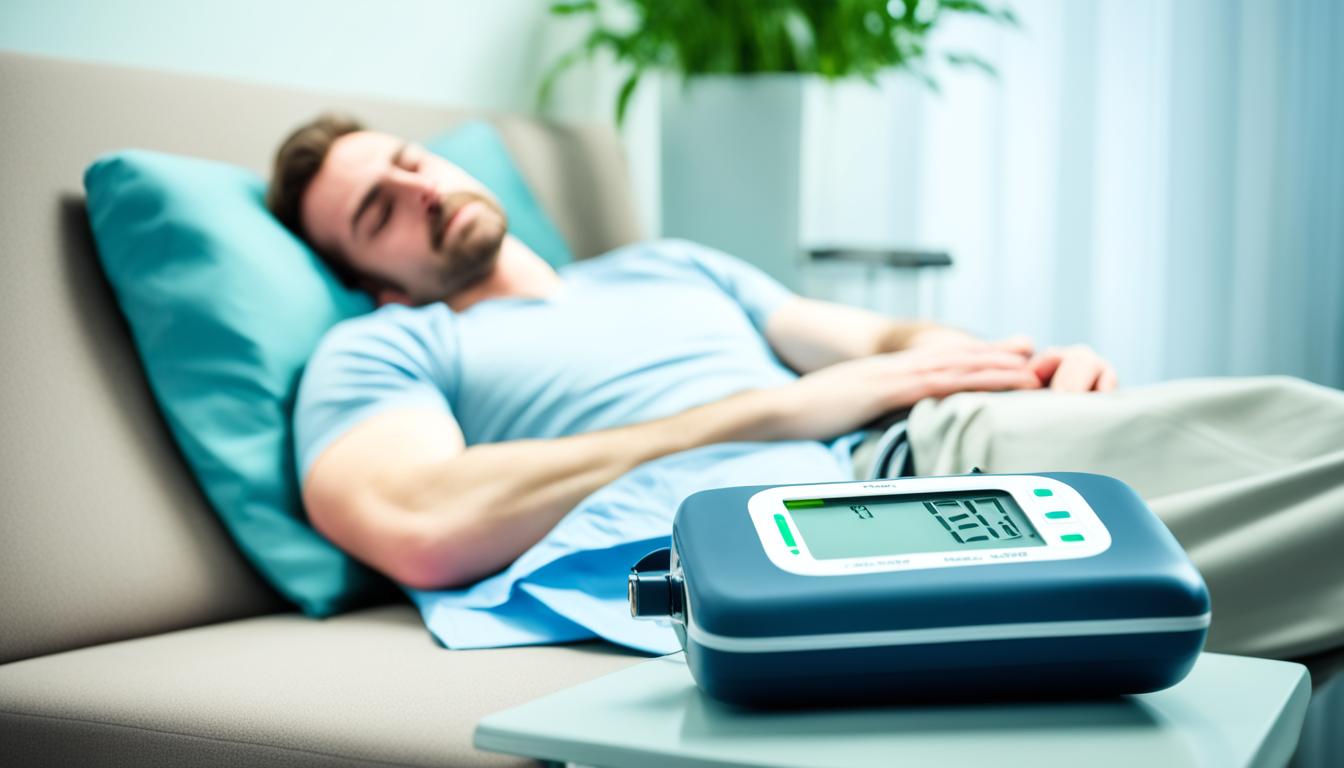Hypotension, or low blood pressure, is when your blood pressure is lower than it should be. This can happen for many reasons and shows various symptoms. Doctors check your blood pressure to see if you have it. Recently, using stem cells to treat hypotension has shown positive results.
Key Takeaways:
- Hypotension, or low blood pressure, occurs when blood pressure levels are lower than normal.
- Symptoms of hypotension can include dizziness, lightheadedness, fainting, blurred vision, fatigue, and difficulty concentrating.
- Common causes of hypotension include dehydration, heart conditions, certain medications, pregnancy, and age.
- Diagnosis involves measuring blood pressure and identifying underlying causes.
- Stem cell therapy is a promising treatment approach for hypotension, showing potential for improving blood pressure regulation.
Common Symptoms and Risk Factors of Hypotension
Low blood pressure, known as hypotension, has various symptoms and risks to look out for. Knowing these can help with early detection and proper management. This info is key for tackling hypotension effectively.
Symptoms of Hypotension
The signs of hypotension can change based on how severe it is and the reasons behind it. People might experience:
- Dizziness
- Lightheadedness
- Fainting
- Blurred vision
- Fatigue
- Difficulty concentrating
These symptoms can truly affect your daily life and health. It’s very important to notice them and talk to a doctor if they don’t go away.
Risk Factors for Hypotension
A few points can make someone more likely to have hypotension. These include:
- Dehydration
- Heart issues, like a slow heartbeat or faulty heart valves
- Some medicines, such as blood pressure drugs or antidepressants
- Pregnancy
- Getting older
Knowing these risk factors is crucial. It helps identify those more at risk and suggests steps to prevent hypotension.
Diagnosis and Management of Hypotension
Hypotension, or low blood pressure, is found by checking blood pressure with a sphygmomanometer. If blood pressure is under 90/60 mmHg, it’s low. Yet, one reading doesn’t instantly mean someone has hypotension. Doctors ask about your health past and do a check-up to find the real cause.
Treating hypotension changes based on the reason it’s happening and how bad the symptoms are. At first, doctors suggest changes to how you live. This might mean more fluids and salt to bring your blood pressure up.
Also, using compression stockings helps by making sure blood flows well in your legs. This stops blood from collecting and causing low blood pressure. It’s also good to stand up slowly to avoid feeling dizzy.
Sometimes, doctors give medicines to help keep your blood pressure normal. These drugs make you feel better if you have symptoms from low blood pressure.
Management Strategies for Hypotension:
- Increasing fluid and salt intake
- Wearing compression stockings
- Avoiding sudden changes in posture
- Using medications to regulate blood pressure
Lifestyle Modifications for Hypotension Management
| Lifestyle Modification | Description |
|---|---|
| Increase Fluid Intake | Drinking more fluids, like water and drinks with electrolytes, boosts your blood volume and blood pressure. |
| Consume More Salt | Including more salt in your food helps your body keep fluids, raising your blood pressure. |
| Wear Compression Stockings | These stockings make sure blood moves well in your legs, reducing hypotension symptoms by preventing blood from collecting. |
| Avoid Sudden Postural Changes | Getting up slowly from sitting or lying down stops blood pressure from dropping too quickly, which can make you feel lightheaded or dizzy. |
For anyone with hypotension, it’s key to team up with doctors. They can help pick the best ways to manage based on your health and past.
Breakthroughs in Stem Cell Therapy for Hypotension
Stem cell therapy is a new hope for hypotension patients. It uses the power of stem cells to heal damaged tissues. This method brings hope to those with this condition.
Studies show stem cell therapy can help regulate blood pressure. It works by boosting the healing process with healthy stem cells. As a result, blood pressure can get better.
Stem cell therapy shows great promise in treating hypotension. It’s a new option for those not helped by usual treatments. As more studies are done, this therapy will likely become more common for fighting hypotension.

